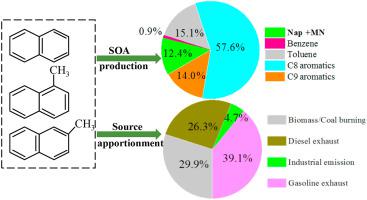Atmospheric Environment ( IF 5 ) Pub Date : 2021-02-26 , DOI: 10.1016/j.atmosenv.2021.118295 Hua Fang , Shilu Luo , Xiaoqing Huang , Xuewei Fu , Shaoxuan Xiao , Jianqiang Zeng , Jun Wang , Yanli Zhang , Xinming Wang

|
Naphthalene (Nap) and methylnaphthalenes (MN) are among important intermediate volatility organic compounds (IVOCs) that contribute substantially to the formation of secondary organic aerosols (SOA), yet studies about their ambient levels, source contributions and SOA productions are quite limited. In this study a field campaign was conducted from September 23rd to October 4th, 2019 at an urban site in the megacity Guangzhou in south China for characterizing ambient Nap and MN. Measured Nap, 2-MN, and 1-MN concentrations were 94.0 ± 23.1, 25.3 ± 4.5, and 11.8 ± 2.1 ng m−3 (mean ± 95% C.I.), respectively. Initial levels and chemical losses of Nap and MN were estimated using a photochemical age-based parameterization method, and results demonstrated that on average ~60% of Nap + MN were degraded during photochemical ageing. During the photochemically active period (12:00–15:00), Nap and MN could contribute 12.4% of estimated SOA formed from single-ring aromatics, Nap and MN altogether, while their initial levels were less than 2% of single-ring aromatics. Source apportioning by the positive matrix factorization (PMF) coupled with the photochemical age-based parameterization revealed that gasoline exhaust was the largest source, accounting for 39.1% of Nap and MN, followed by biomass/coal burning (29.9%), diesel exhaust (26.3%) and industrial emission (4.7%).


























 京公网安备 11010802027423号
京公网安备 11010802027423号